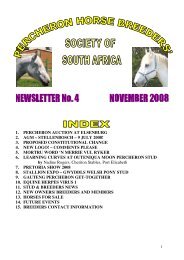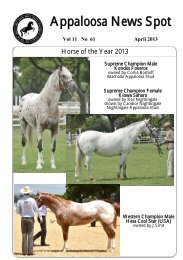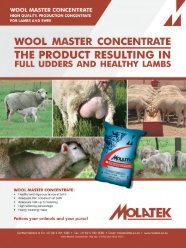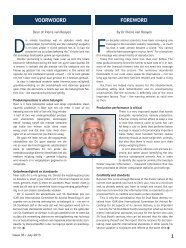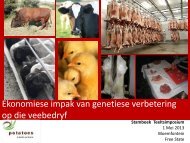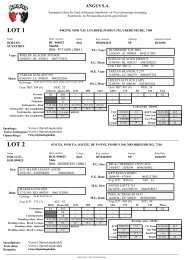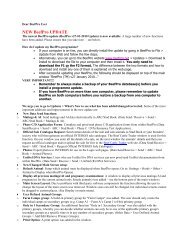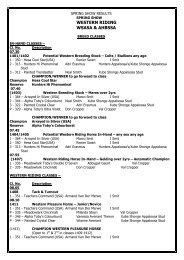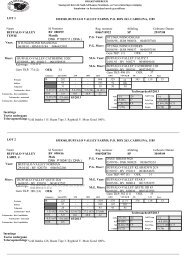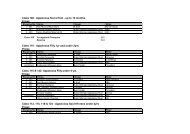Kliek hier vir bladsy 36-48 - SA Stamboek
Kliek hier vir bladsy 36-48 - SA Stamboek
Kliek hier vir bladsy 36-48 - SA Stamboek
Create successful ePaper yourself
Turn your PDF publications into a flip-book with our unique Google optimized e-Paper software.
BESTUUR / MANAGEMENT<br />
Perspective on<br />
mineral supplements<br />
By Dr Jasper Coetzee, sheep nutrition and management specialist consultant<br />
Livestock breeders have to familiarise<br />
themselves thoroughly<br />
with mineral shortages and/or<br />
imbalances that may occur, as<br />
these can have a negative effect<br />
on the production, reproduction and<br />
health of grazing animals and the digestion<br />
of their feed. The cost of rectifying<br />
these problems is often negligent compared<br />
to the results achieved.<br />
Production and reproduction tempo, as<br />
well as the health of grazing sheep and<br />
cattle, are often adversely affected by the<br />
occurrence of marginal mineral shortages<br />
and/or imbalances, which have a significant<br />
impact on animal performance even<br />
before any clinical (visible) signs of shortages<br />
are observed.<br />
Production losses<br />
It is estimated that mineral and vitamin<br />
shortages can bring about a 2% loss in<br />
overall production in sheep (Court et al.,<br />
2010). One factor that is often ignored, is<br />
that the micro-organisms in the rumen of<br />
the ruminant require a series of minerals<br />
to ensure optimal and effective digestion<br />
of ingested grazing. These shortages can<br />
be the direct result of too low levels of<br />
minerals in the grazing, or of excessive intake<br />
of certain minerals known as antagonists.<br />
Animals’ mineral requirements are<br />
highly dependent on their physiological<br />
stage and productivity level, which means<br />
that, as the animal’s production and reproduction<br />
increase due to crossbreeding, selection<br />
progress and/or improved management<br />
practices, its mineral requirements<br />
will increase accordingly. Marginal mineral<br />
shortages in animals presenting a low production<br />
level, will increase even more as<br />
production and reproduction increase.<br />
The mineral and vitamin requirements<br />
of ruminants have been published in various<br />
text books and articles. These tables<br />
reflect the estimated minimum requirements<br />
(Lee et al., 2002) of an average animal<br />
under normal conditions, but do not<br />
take into account the differences between<br />
animals, grazing and the en<strong>vir</strong>onment. In<br />
other words, these tables serve only as a<br />
guideline.<br />
Feed scientists do estimates based on<br />
grazing, soil and water analyses, as well as<br />
tissue, blood and bone analyses of animals,<br />
to determine which minerals and at which<br />
levels should be supplemented via licks<br />
for animals on a specific farm, especially<br />
where animals are not performing according<br />
to their genetic potential.<br />
Monitoring<br />
Continued monitoring of the mineral status<br />
of a sheep and cattle herd, as well as<br />
the observation of typical symptoms of<br />
mineral shortages, is an essential part of<br />
a general management programme. Socalled<br />
dose response trials are often used<br />
as opposed to a control, in order to confirm<br />
a shortage and to determine a reaction to<br />
a supplement.<br />
When determining livestock’s mineral<br />
requirements, one should always consider<br />
the possibility of extreme climate conditions<br />
and the fact that animals’ needs increase<br />
as they move over great distances<br />
while searching for grazing. However, animals’<br />
mineral requirements become less<br />
important when they are exhibiting an energy<br />
and/or protein shortage.<br />
It therefore appears to be uneconomical<br />
to supply mineral supplements to grazing<br />
animals if they are experiencing an energy<br />
and/or protein shortage. On the other<br />
hand, if energy and protein are sufficient, a<br />
high level of minerals is required to maintain<br />
a high growth rate. Mineral shortages<br />
and/or imbalances can be rectified by supplementing<br />
it in licks specially formulated<br />
to supplement shortages in a natural manner.<br />
It is also the most economical method<br />
to supplement mineral shortages.<br />
Beware of too much<br />
Grazing animals obtain their minerals by<br />
ingesting grazing, water, soil and licks.<br />
Often too high levels of certain minerals,<br />
so-called antagonists (such as calcium,<br />
iron, sulphur, molybdenum, sodium and<br />
potassium), occur in one or more of these<br />
sources. This has a negative effect on the<br />
absorption of other minerals and leads to<br />
mineral shortages.<br />
For example, a too high intake of calcium<br />
from lime-rich drinking water can<br />
lead to a shortage of manganese, zinc, selenium,<br />
copper, cobalt, iodine, phosphorus,<br />
magnesium and vitamin A. It is therefore<br />
recommended that part (30 to 50%) of<br />
the trace elements in a lick is supplied in<br />
organic format (Short, 2006).<br />
Supplementation of minerals, trace<br />
elements and vitamins for grazing animals<br />
cannot be done only through licks – not<br />
all animals eat licks or take in sufficient<br />
amounts of lick. Up to 18% of the sheep<br />
in a herd don’t ingest any lick (Lobato<br />
et al., 1980) and up to 30% don’t ingest<br />
sufficient amounts of lick (Pinchak, 2000).<br />
Approximately 17 to 38% of cattle in three<br />
studies ingested no lick, while up to 30%<br />
ingested only small amounts of the lick<br />
(Bowman & Sowell, 1997).<br />
This lends credibility to the view that,<br />
during strategic times of the year (prior<br />
to the breeding seasons, before the lambing<br />
and calving season, at weaning and<br />
upon introduction to a feedlot), an additional<br />
trace mineral supplement must be<br />
given via a dosage or injection of trace<br />
elements.<br />
Macro-minerals can only be supplemented<br />
via licks and producers should<br />
aim for their animals to ingest the recommended<br />
amount of lick. Include the correct<br />
level in intake-inhibitors in the licks<br />
and practise correct lick trough management<br />
(e.g. placement of lick troughs).<br />
For more information, phone the author<br />
on 076 846 8800 or email<br />
jasperco@iafrica.co.za. SB<br />
Issue 35 ▪ July 2013<br />
39



